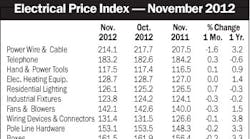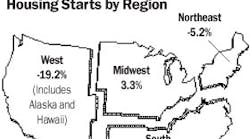Latest from Mag
People - Dec 21, 2012
Obituaries - Dec 21, 2012
November EPI Index Shows No Change
Housing Starts Dip 4% in November
Electrical Marketing - December 21, 2012
Around the Industry - Dec 21, 2012
After three years of negative growth, electrical distributor industry sales finally registered positive growth in 2004. Led by the distributor served industrial market, DISC Corp., Orange, Conn., a leading provider of market forecast information for the electrical industry, expects total industry sales to top 6.5 percent this year and better than 8 percent next year.
Over the past 30 years, average annual growth has been 6.2 percent, so 2004 is right on target with the long-term historical growth rate. We’ve seen some fairly spectacular commodity price increases over the past year and that translated into a 5.8 percent price increase for the electrical industry overall. Taking account of the price effect this year, real physical volume — the best measure of changes in real resources — increased about 0.7 percent. (That’s over a full percentage point less than the long-term average). What’s so important about that? If you are adding or taking out resources from your business, you want to make sure those decisions are based on changes in physical volume, not on price changes.
Looking back at industry performance over the past year, what stands out is the turnaround in construction activity. Last year, the distributor-served contractor market declined 9 percent. This year, contractor sales will increase better than 5.5 percent — an impressive 14-point swing.
The residential market has been a mainstay of the overall economic recovery and has been important to electrical distributors serving that sector. Spending for residential construction (after inflation) was up 10 percent in 2004; housing starts grew more than 4 percent from 2003 levels. That is not nearly the whole picture, though — residential construction increased almost 9 percent last year, but the distributor-served contractor market still managed to decline 9 percent.
The difference has been the change in nonresidential construction. After decreases of 2 percent in 2001, 18 percent in 2002 and more than 5.5 percent last year, nonresidential construction spending finally increased nearly 3 percent in 2004.
DISC Corp. analysis has consistently shown that nonresidential construction spending is the single most important driver of total industry performance. That in itself is a broad-based indicator for many distributors. For some distributors the bread-and-butter nonresidential indicator is commercial construction — office buildings and shopping centers.
Over the past three years, commercial construction has declined to the tune of negative 6 percent in 2001, negative 20 percent in 2002, and negative 8 percent in 2003. At the same time, another important driver, factory construction, has been falling on average at double-digit rates since at least 1999. This year, commercial construction will be up almost 2 percent, and next year should grow another 7 percent. We expect factory construction to increase better than 10 percent next year.
All in all, this bodes well for the distributor-served contractor market. In 2005, distributor sales to the contractor market should increase almost 8 percent, primarily on the strength in the nonresidential construction sector.
The distributor served industrial market has performed relatively well over the past two years. Industrial sales finally turned the corner in mid-2003 and have been on an increasing growth path for the last year and a half. In the third quarter of 2003, electrical industry sales to the industrial market increased 2 percent over the year-ago quarter. By the end of this year, industrial sales will be moving up at a 9 percent clip. For 2005, DISC Corp. looks for sales to the industrial market to increase 9.5 percent.
One of the indicators DISC is interested in at this point in the economic cycle is the employment data released by the U.S. Department of Labor. The release for October showed a strong increase of 337,000 new jobs — very good performance that needs to be sustained for the recovery to continue on a healthy growth path.
Looking at the job-growth components, however, most of the gain is in the service sector, up 272,000 jobs. The construction sector was up 65,000, which is a welcomed change. But, it is not clear how much of that gain is related to rebuilding due to the hurricanes that struck the Southeast in September and how much is a result of underlying strength in the overall economy.
In a separate DISC report, we have tried to build in the impact of the storms in the most badly damaged metro areas. In general, we are looking at increases in distributor sales of around 30 percent in rebuilding-selected metro areas.
Inflation is always a big unknown. A year ago, who would have predicted gasoline prices over $2 a gallon? For the electrical industry we are forecasting basically no inflation over the short term.
The bottom line: DISC forecasts for distributor sales to embark on an 8 percent growth spurt in 2005 and 4 percent in 2006. The industrial market is expected to lead the way. The contractor market should improve again next year as nonresidential construction strengthens, but DISC sees weakness in the residential market.
To end on an upbeat note, as we track this cycle we are expecting industry performance in the low single digits until 2008. This is a far cry from our experience last year and in the previous two years.

